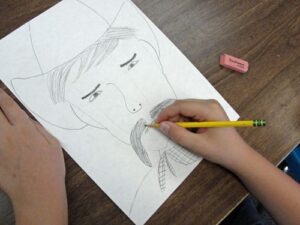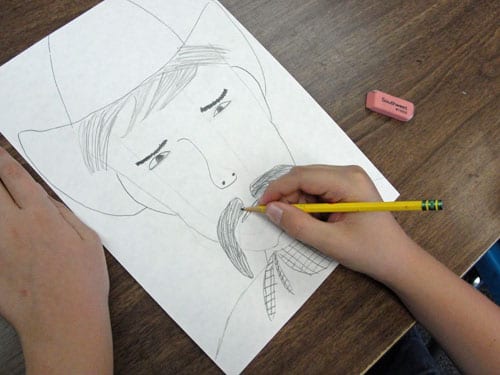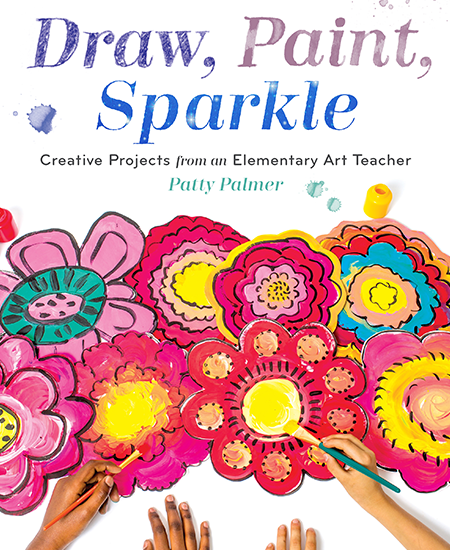
I received this question via email today and thought my answer, plus any comments from readers, might help Megan out. Here is her question:
Hi Patty,
First I want to thank you for sharing all of your ideas! As a new teacher, with so much to learn and a lot of other things to juggle, it’s nice to try things out that I know have worked in the past. I noticed that you had written about using pencils in the Cardinal lesson like it was a rare thing. Do you not let your students use pencils to draw? Do you have them draw right away using markers/crayons? Does this work out better? I give my students pencils and erasers (they have them in a bin at their tables) I do noticed that some students erase A LOT and don’t have the confidence in drawing, they always are asking for help or for me to do it for them (which I wont do)…but I am wondering if they didn’t have the option to erase would they not ask for help as much or “re-do” their work as much… hmmm?
Thanks for your input! You’re great! 🙂
Megan Lesser, Schnecksville Elementary School, PA
Megan,
You aren’t the only one who has asked this question. Anyone who follows my blog or has purchased any of my art lesson booklets, knows that I have a theory about pencils.
It’s been my experience, that given the opportunity to work with pencils, the project will take A LONG TIME. For little ones, the pencil lead is just so tiny that tiny drawings are often the result. Usually not what I’m going for. For older kids, they know they can erase pencil, so they do. Again and again and again.
For most of my lessons, and assuming that the project involves drawing, I use oil pastels or markers.
My reason is simple: it encourages kids to draw big.
If the kids make mistakes, recovering from the mistake is a huge part of my art class. Mistakes are either fixed or ignored. Tempera paint hides most mistakes. If a line is drawn where it shouldn’t be and paint won’t cover it up, then the kids are encouraged to brainstorm on how that one wayward line can evolve into part of the artwork. It usually does and the artist feels empowered.
For black markers, mistakes are covered in much the same way.
But I have to stress that I’m very specific which art project calls for oil pastel and which ones are more suited to markers. I almost always specify in my posts or tutorials. But here is my general rule of thumb: oil pastel (or crayon) for large subjects and markers for line drawings with details.
WHEN PENCILS ARE NECESSARY…
I do use pencil in projects in which fine details are encouraged. My 6th graders have been working on a pen and watercolor painting of “Painted Ladies”. The details in the architecture plus my technique for drawing the house involves pencils first, tracing and much erasing. Needless to say, this lesson takes a long time. But it’s worth it.
It’s also important to note, that I am an illustrator and spend a lot of time teaching my students how to draw. I show them how to look at an object and simplify the drawing process and most importantly, how to cover up “mistakes”. I’m good at that!
I hope this helps, Megan. Other art teachers might have a completely different take on pencils. Hopefully, they will weigh in!




Great post! I recently took your advice and used markers with a first grade lesson. I was amazed at the results and suprised by how much smoother the lesson went! I never would have believed it if you didnt preach it so much and I hadnt tried it for myself! THANKS!
I couldn’t agree more, teaching 25 years will make you see that pencils make most kids tight, draw small and rely on that eraser. I will have my kids draw with pencil to make an overall shape first, but VERY LIGHTLY, like drawing on a marshmallow so the tip doesn’t get sticky!! Then any details, we do with sharpie. What’s the point of doing it twice. I too want them to be creative when they make a line they didn’t want. I too know by now, which drawing projects lend themselves to other drawing media. Good luck.
You said it best. Pencils can make a child tight.
Hi Patty,
I use pencils for certain things: learning perspective, for example, or assignments where the details are critical. We do a lot of practice with pencil, and also some observational drawing. Recently my 3rd graders did self-portraits looking in the mirror. There was a bit of erasing, but I think the results are worth it. (When we have them all finished up, in about a week, I’ll post them. They are very cool.) Same thing when my 1st graders drew each other; the pencil is critical in getting it right. But we do contour line w/markers or crayons, and I use Sharpies a lot too, but not oil pastels as much as you. When we paint, we do a lot with a chalk line to start, and outlining with black paint, which I like better than oil pastel once they learn to do it.
I started at a new school last week, and my kids are driving me CRAZY with the pencil talk. The older ones seem to think drawing with markers is only for little kids or something. I’m trying to get them to work with their mistakes, but it’s a new concept to most of them. There have been several crossing out drawings and such. NOOO. You just told everyone you messed up with the crossing out! I hope that I can get them comfortable with drawing with other media besides pencil.
Oooh…crossing out drawings and asking for a new piece of paper is the worst! I think that might be my biggest pet peeve! So hard to negotiate…
EEEGad, I had two kids in two kids in one class and 3 kids in another class do that today.
Big giant X’s through their work. Who taught them that THAT is ok to do??????
I am on such a tight budget that only have enough paper allotted for each class and maybe one or two extras. Yikes, that is a nightmare!
So now, I have to go buy another ream of paper out of my own money to cover the loss.
FRUSTRATING!
I always tell my students they have two sides to their paper. So when they are frustrated and unhappy they can turn the paper over and start again.
Never thought about the pencil making them draw small~ duh! Today I was letting my Kinders show me what animals they could draw. They started with pencil and the drawings were tiny. Then I asked them to draw a specific animal and they used oil pastels and the difference was big! With the oil pastels they are moving their entire arm to draw and had more control for the most part. I’m going to adopt this into my way of teaching. Thanks!
Last week I had 5th graders using oil pastels to practice shading cupcakes to give the illusion of depth. You should have seen some of their faces when I said, “No pencils on this one, other than to write your name ad room # on the back.” You’d have thought I’d just taken away their most precious possession!! But, as soon as they started in with the oil pastels, they were totally engrossed and didn’t miss the pencils a bit!
I am personally uncomfortable with using things other than a pencil to start a project, I guess that’s just my confidence level showing! I still let the students use their pencils, but I cut the erasers off and give them one eraser to share at each table. The erasers are kept in the supply area. If a student really needs an eraser they have to wait until the supply area is empty of other students and walk to the table to get one. I feel that this makes them think about if they really need to erase their mistake, or just keep moving on. Seems to be working so far this year! And the students are really responsible with the erasers, they have to match them with their table color when they return them.
When I introduce a new drawing lesson we usually have a “practice day”. I get out the newsprint or manila paper and we do a guided drawing. All year when ever we do one of these, I always say no erasing. I say over and over, this is practice day you make all the mistakes you need to but don’t erase. I encourage them to redraw a better line, shape what ever, darker or move to a clean spot and redraw it. I do this mostly with K-2 and then by 3 &4th it is less intimidating, I hope.
I do let them erase after they draw the whole thing and then outline in marker or crayon so they can see the best part. After a practice day (35 min) we come back the next class (two days later) and do our “final” drawing.
It works for me, but I do have them draw w/o pencils once in a while if they are sneaky erasers during class. 🙂
The pencils I use in my art room are ‘primary’ pencils – thick, soft lead & no eraser on it. When we do directed drawing lessons, no erasers on the tables until the main object is drawn. The directed (step-by-step) drawings are timed so they focus on individual, specific steps & keep up with others. They have time later to make ‘changes’ and elaborate. By then they usually prefer to turn over the paper and try again rather than erase. For the eraser-huggers, I often take erasers away if they are not moving along. After all – we’re practicing our drawing skills not erasing skills…
Thank you for all your inspiration on your blog. Would love to see examples/samples of how you teach the kids to incorporate their mistakes into their art.
I am a big believer in giving every child the chance to “warm up”! Just this past week I taught a lesson to first graders on how to draw penguins. I gave them pencils and had them follow my example as I drew on the wipe off board. I begin with shapes and connecting them, etc to get the desired object. So pencils are beautiful for a warm up exercise. I let the kids draw over and over their shapes until they feel great about the size and shape of their object ( i.e. penguin) BIG pink pearl erasers are on hand for the very distraught because art should not provoke tears.
Then I hand out the “special” paper that they only get ONE piece of and have them ink it in with a sharpie, looking at their warm up for inspiration. It has worked well for me and seems to provide the kids the buffer they need to engage the right side of the brain!
Yes, this is a great technique and I can see how it would work. My problem is that I see the kids so few times during the year (only 15 art classes) so I want to make the most of my time with them. Control freak, maybe? I believe your method sounds spot on. Warming up, given that the children know that it is such, is a great way to go. Thanks for weighing in!
This sounds like a great idea! It being my first year teaching I sometimes have trouble describing in a simple way to the students what to draw. I find myself saying it one way and then I noticed they didn’t do quite what I expected, then I’ll quickly correct myself and describe it another way and I see them make changes that are quite excellent! It’s like “Ahhh” that’s better! 🙂 I also have used news print before and had some sketching” “practice” time before the final drawing.
I WILL be trying more projects out with using markers/crayons/pastels first though, I can’t wait to see the difference!
Thanks to everyone who has added feedback!
My students never use pencils for drawing projects. The pencils control their imagination too much…they know they really don’t have to think much about what they put on their paper because they can erase, and erase and erase some more. They are just not challenged as much as if they drew with a black crayon or marker. I do put pencils out for free drawing time, but the students usually use the markers or black crayons. When we begin a project we draw on one side, then flip over and start again…then we decide which one we like the best and go forward with the project. I realize others use pencils, but they don’t work for my K-2 classes. Most of my students are confident in their work and solve their problems in their drawing without stressing over them.
Hi Patty, I am new to your site. Love it!
I love this new approach of NO PENCILS.
I have taught art three days a week,part time at one school for 5 years. recently I got hired at another school the other two days a week.
At my old school, the kids are used to having their pencils and Magic Rub erasers (my personal favorite.. I buy a few boxes and cut them in half, they last for years, they even erase colored pencil).
I agree that they draw too small with the pencils and erase too many times. As I collected their most recent watercolor project I was saddened to see all the projects with PENCIL GHOSTS in the background. Pencil Ghosts are the horrible lines left from drawing and redrawing and redrawing and erasing and redrawing etc.. where the paint didn’t cover. So sad!
So at my new school,I decided to try something new. Since these kids had never had art before, I got to make up my own rules.. a DO-OVER!
The last two projects have been done using a black marker on the Crazy Picasso face, and a white oil pastel(on black paper) for a lion face, Henri Rousseau drawing. I have noticed that since these kids have never been exposed to drawing with pencils, they don’t know what they are missing. They are finishing on time, no wasted erasing times and with no horrible pencil ghosts in the background.
YAY!!!
I’m a big believer in the no pencils mentality. There are times, of course when they’re needed, but most of the time, pencils provide a way for students to get stuck trying to create something perfect.
laurie dyer
If I’m doing a drawing lesson in preparation for a painting I use white or yellow chalk. I find that children use pencils as if they are doing a math problem. They apply too much pressure, they hold them wrong and they erase too much and ultimately they have a hard time visualizing how much more space a paint brush uses up. Chalk works nicely for these reasons. In addition, the marks it leaves on the paper aren’t as dark as pencil and the imperfections are not as noticeable to the students which gives them a little more confidence in their drawing ability.
I do use pencils for some activities but keep a watchful eye on how the students are using them. They just seem to have a different mind set when it comes to using them in the art room. After all they use them in the classroom for so many other things that they have a natural tendency to use them in this manner.
I very rarely use pencils and erasers are in a box on my desk. I use them for names and class code on the back and erasers for perspective. I have a poster I made, “In art: it is not a mistake… it’s an opportunity!” From day one, they learn not to cross it out, but to turn it into something in their picuture, so I am in favor of using markers/”sharpies” 90% of the time. They also only receive one piece of paper and if no “sharpie” is being used, they can always use the other side of the paper if it is in the first part of the drawing. I have been using markers for years and the kids don’t think about it now.
BTW- thanks for all the great posts that encourage, demonstrate and show appreciation for art specialists, the “forgotten and sometimes not appreciated educational discipline.”
I let my kids use pencils, unless there are time restraints. I also give them big pink pearl erasers. Especially for my kinders, I think tracing over their lines with marker is good for their fine motor skills. They also learn to clean up their drawing by erasing their pencil lines after tracing, before coloring or painting. I think starting in marker or pastel would freak them out. That might be kinda fun too. hmmm